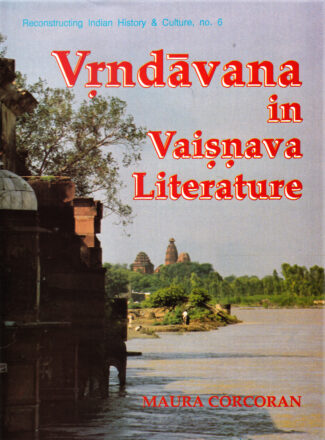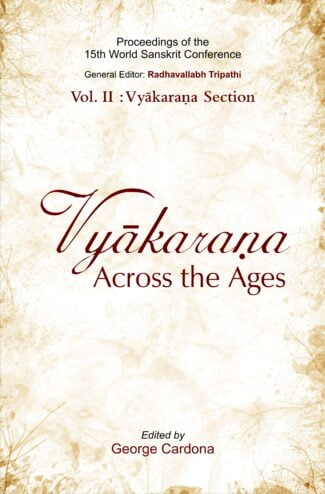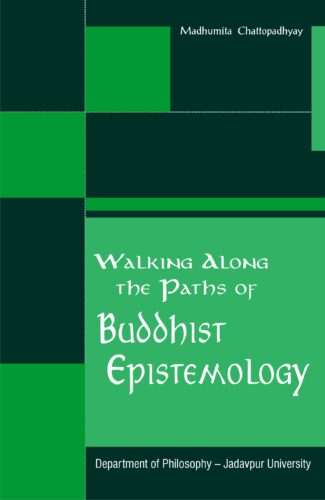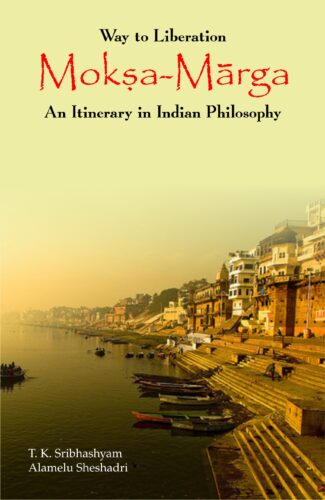Showing 1129–1140 of 1187 results

It mainly tries to postulate an alternative explanation to the vratya-phenomenon correlated with the heterodox facets of Indian sovereignty. Thus, the work consistently offers a new historical interpretation of the rise of the so-called orthodox Brahmanic (Shrauta-) culture that is understood as a reform.
This volume stems from the three-year Research Project Traces of a Heterodox Concept of Kingship in Ancient, Medieval and Modern India financed by the Regione Autonoma della Sardegna, developed by Cristina Bignami, Danila Cinellu, Ewa Debicka-Borek, Moreno Dore, Elena Mucciarelli, Chiara Neri and coordinated by Tiziana Pontillo. It mainly tries to postulate an alternative explanation to the vratya-phenomenon correlated with the heterodox facets of Indian sovereignty. Thus, the work consistently offers a new historical interpretation of the rise of the so-called orthodox Brahmanic (Shrauta-) culture that is understood as a reform. Moreover, it resorts to a large collection of ancient, medieval, and modern texts and documents, interpreted by means of philological and anthropological tools. In this manner, the Vratya problem is launched onto a interdisciplinary platform, in order to profit from a broad scenario as far as this issue is concerned.
The first section focuses on the vratya culture, as it can be reconstructed from old (and middle) Indo-Aryan generally marginalized sources, and from medieval and modern documents where this culture seems to have left some traces. The second section seeks to substantiate the polar opposition between orthodox and heterodox sovereignty, of which vratyas appear to be a capital example.
Morality for the Ailing and Others: An Anthology on Applied Ethics, volume 2 is a collection of ten articles written by distinguished scholars who have provided exciting and interesting introduction to some domains of medical ethics, environmental ethics, ethics of politics, exploratory account of moral domains centring female sexuality, women’s position in society and prescribed code of conduct for women and analytic explanation of some hard-core ethical concepts and theories. This publication aims at carrying out the task of emphasizing the link, if any, between hard-core ethical theories and their applications to real life practical situations with special reference to Indian texts and literature. However, any holistic approach to ethics as a branch of philosophy hardly can deny drawing some contrast, comparison and analogy with the Western paradigms. The present anthology is no exception to this custom. Strictly speaking, this is a book on Applied Ethics which aims at exploring concrete suggestions, as far as possible, to meet challenges posed before human beings arising from moral conflicts and dilemmas at different levels of life. Whoever is interested in applied ethics – whether a researcher or a student or a lay reader – will be enormously benefited by the richness of the content of this volume. Authors have sharpened theoretical tools as per their requirements and credibly covered some of the fuzzy areas of practical moral situations. Articles are written in clear language and in very lucid but argumentative style.

The book explores the essential nature of Vrndavana, analysing various Vaisnava texts mythological, meta-physical, devotional and commentatorial. It identifies a notional sequence of ideas connected with Vrndavana the description of a mythic place, a symbolic place, etc.
A well-known geographical site on the banks of the Yamuna, about 150 kilometers from Delhi, VRINDAVANA is the holiest of the pilgrimages for the worshippers of Krishna. However, in the devotional Sanskrit and Braj Bhasha literatures, another dimension of Vrindavana dominates the picture, i.e., its role as an expression of the divine realm. What, then, is Vrindavana? A terrestrial place of pilgrimage? A mythic locale associated with Krishna and Radha? Or a metaphysical concept symbolizing the celestial space of the eternally-going lila (divine sport)? With sharp focus on these and allied questions, Dr. Corcoran explores afresh the essential nature of Vrindavana, critically analysing the representative texts from the immense corpus of Vaishnava literature of different genres: mythological, metaphysical, devotional and commentatorial. The authors inquiry seeks to identify a notional sequence of ideas connected with Vrindavana: the description of (a) a mythic place, (b) a symbolic place, (c) the geographical town as a centre of pilgrimage. And also looks at other thematically relevant concepts, for instance, avatara (incarnation) and lila (divine sport), underlying the entire understanding of the nature of the divine and the relation of the divine to the material world. The book exhibits a striking departure from modern sources which have, for the most part, concentrated on Vrindavana as a geographical place, glossing over its symbolic and mythic significance.

Covering the papers presented during the 15th World Sanskrit Conference, this book deals with Sanskrit grammatical treatises such as Eropean traditions of Sanskrit grammers; relations between terms and their meaning; the derivation of nominal forms in the Sàrasvata system; and the realm of modern Sanskrit literature, among others.
Sanskrit grammatical treatises, not only those of Panini and his successors but also work by Indian scholars representing other streams of grammatical thought, have long held the attention of modern scholars. The present volume contains a selection of the large number of papers presented in the Vyakarana Section of the 15th World Sanskrit Conference held in New Delhi, during 15-20 January 2012.
The scope covered in these papers is wide. The first contribution deals with currents in European traditions of Sanskrit grammars, from early works by missionaries to modern Sanskrit grammars. As could be expected, however, Panini is the centre of attention for most authors, whose contributions nevertheless differ in focus. Several scholars deal with theoretical issues concerning the interpretation and application of Paninian sutras, including points of Sanskrit syntax. The question whether particles (nipata), and preverbs (upasarga) in particular, should be considered independently to signify particular meanings or instead be treated as terms which serve to cosignify meanings assigned to items with which they co-occur is the object of two studies.
One paper treats in detail the relations which can be considered to hold between terms and the meanings they signify, with particular emphasis on what Bhartrihari has to say on this topic. A historically-oriented study deals with attacks on Paninian views by Mimamsakas of Prabhakara Naiyayikas. One scholar contrasts how particular nominal forms are derived in the Sarasvata system in contrast to the Paninian derivations of such forms. The final study in this collection brings us into the realm of modern Sanskrit literature, with a discussion of usage in the prose work Shivarajavijaya of Ambika Dutt Vyas.
Fellow scholars should welcome and profit from the varied studies contained in this volume.

Vyangyavyakhya (interpretation of implied sense), ninth century, is the first performance text in Sanskrit applying dhvani to Bharata’s theatre. The author Kulasekhara deserves a place next to Anandavardhana and Abhinavagupta in the history of Natyasastra studies. The text is published for the first time.
The doctrine of dhvani, expounded by Anandavardhana (ninth century ce) in Kashmir though contested by his contemporaries at home, received sound acclamation in Kerala. A royal dramatist Kulashekhara of the same century applied dhvani to the theatre. His performance text is known as Vyangyavyakhya (VV), meaning interpreting the implied. This was an epoch-making event in the history of Indian theatre. This innovation in performative practices marked a deviation from Bharatas national tradition and laid down the foundation for classical forms like Kutiyattam, Kgrshnanattam, Kathakali and Mohiniyattam. VV today continues to inspire contemporary directors to formulate new interpretative sub-texts for ancient plays. VV, which remained in manuscripts till now, is published for the first time.
As icing on the cake, four eminent scholars K.D. Tripathy, Radhavallabh Tripathi, N.P. Unni and Kavalam Narayana Panikkar delve deep into the aspects of VV as introduction to this book. This volume discusses in detail the Sanskrit theatre until tenth century ce, performance texts of Dhananjayadhvani and Samvaranadhvani, and the developments in the post-Kulashekhara era.
VV should serve as a guide to all practitioners of performing arts, and should entice students, teachers and lovers of Indian performing arts.

This is a book on Buddhist epistemology dealing with different epistemological topics like the nature of knowledge, validity of knowledge, knowledge of knowledge, perception, erroneous perception, among others. The author has referred to different Sanskrit texts and literature available on these topics.
The monograph highlights the philosophical arguments offered by Buddhist thinkers on different aspects of knowledge. Various aspects of Buddhist epistemology right from the basic question of what the Buddhists mean by knowledge, the varieties of knowledge according to their belief and their explanations of the validity of knowledge are examined. A painstaking work of Prof. Madhumita Chattopadhyay, this study deals with different epistemological topics like the nature of knowledge, validity of knowledge, knowledge of knowledge, perception, erroneous perception, inference and its related issues like ascertainment of vyapti, antarvyapti, prasanganuman and fallacies of inference. The author has referred to many primary sources which include different Sanskrit texts as well as the latest secondary literature available on these topics and discusses the important role of concept of absence and the theory of apoha or negative nominalism as a substitute for universals in Buddhist metaphysics. An attempt is made to explore whether solutions to modern epistemo-logical problems as found in the Western tradition can be provided from the Buddhist perspective in order to show that Buddhist epistemology has a relevant role to play in the area of epistemology itself. The book would interest scholars and students interested in the epistemological and logical aspects of Buddhist philosophy.

It is a comprehensive study of the defence policies, construction of forts, arms and ammunitions, commissariat, the espionage system, the rules of aggression and defence, the technical matters and war ethics, based upon a comparative study with the modern systems, and a thorough comprehension of Sanskrit, Sanskrit sources, and works like Silappadikaram, and Kural.
Differing from the existing studies on the warfare of ancient India; Warfare in Ancient India: In Historical Outline is a comprehensive study of the defence policies, construction of forts, arms and ammunitions, commissariat, the espionage system, the rules of aggression and defence, the technical matters and war ethics, based upon a thorough comprehension of Sanskrit and Sanskritic sources. This being done based on the existing and newly-explored sources. It also analyses the diplomatic and economic factors in aggressive designs, one of the major elements of the political history of early India.
This volume partially deals with the activities of the Indo-Aryans and their continuous struggle for survival against hostile environment in Indus Valley and their expansion towards the east along the major rivers of north India, leading to frequent invasions and attacks. Thus came the warlike traits of some major Vedic deities, ancient battles, arms and armour, chariots, forts, arrays, Jain war canons, and major weapons cited in the Mahabharata, Silappadikaram, Manasollasa, Kural, etc. as the main focus of the book. It also vividly addresses the war policies and tactics enunciated by Kautilya in Arthasastra and Manu in Manu-Smriti, and differentiations in their views on few aspects. The inevitable factors that led to wars survival, and domination and economic exploitation are also well dealt.
The book should enthuse the interests and spirit of all those who are into the study and research of history, warfare and ancient Indian culture mainly from the Vedic viewpoint.

The book projects light on concept of contemplation and meditation, including meditation techniques and practices, which is central to the attainment of moksha. It also explains meaning of love, devotion, religion, the body-soul relation and the three yogas understanding of which is essential to attain moksha.
The way to liberation or moksha needs perfect knowledge, perfect action and perfect surrender to the Lord. The bhakta becomes a bhagavata as he not only knows and sees but also lives as a servant of God. Moksha is the final approach to the purity and perfection of the human soul. This volume attempts an in-depth study of the concept of liberation or moksha and the way to attain it.
The book begins with the meaning of love, devotion, religion, the body-soul relation and the three yogas, an understanding of which is essential to understand the concept of moksha. In this context, it delves into the meaning of the Brahman, the Absolute, as conveyed in the Vedas and other religious works like the Upanishads and the Bhagavad-Gita, the concept of the universal spiritual entity of Sarveshvara, concepts of sin and virtue, and even the principles of monotheism and polytheism in Hinduism. Quoting from the scriptures and other relevant texts, it emphasises on the notion of devotion and its benefits to examine the means to self-realisation and liberation and includes a study of the concept of contemplation and meditation, including meditation techniques and practices, which is central to the attainment of moksha.
With interesting illustrations, the volume will be useful to religious scholars and students and seekers on the path of spiritual fulfilment.

The book projects light on concept of contemplation and meditation, including meditation techniques and practices, which is central to the attainment of moksha. It also explains meaning of love, devotion, religion, the body-soul relation and the three yogas understanding of which is essential to attain moksha.
The way to liberation or moksha needs perfect knowledge, perfect action and perfect surrender to the Lord. The bhakta becomes a bhagavata as he not only knows and sees but also lives as a servant of God. Moksha is the final approach to the purity and perfection of the human soul. This volume attempts an in-depth study of the concept of liberation or moksha and the way to attain it.
The book begins with the meaning of love, devotion, religion, the body-soul relation and the three yogas, an understanding of which is essential to understand the concept of moksha. In this context, it delves into the meaning of the Brahman, the Absolute, as conveyed in the Vedas and other religious works like the Upanishads and the Bhagavad-Gita, the concept of the universal spiritual entity of Sarveshvara, concepts of sin and virtue, and even the principles of monotheism and polytheism in Hinduism. Quoting from the scriptures and other relevant texts, it emphasises on the notion of devotion and its benefits to examine the means to self-realisation and liberation and includes a study of the concept of contemplation and meditation, including meditation techniques and practices, which is central to the attainment of moksha.
With interesting illustrations, the volume will be useful to religious scholars and students and seekers on the path of spiritual fulfilment.

How can we understand the Hindu tradition as alive today? That is the question which this book investigates. It asks for a broader understanding of history, rightful accounting of the Vedas and of other oral learnings. The goal of truth is sought by approaching different personalities and institutions of culture.
In India, there has long been a tendency to emphasize the spoken word which is passed on alive from an individual teacher to each individual student. But, through the development of modern media, more use is now made of the written word which records information externally, in institutions that have been industrially, socially and culturally organized. How then can we understand the Hindu tradition as alive today with its ancient emphasis upon the spoken word and the living individual? That is the question which this book investigates. Accordingly, it asks for a broader understanding of history, which would allow for a rightful accounting of the Vedas and of other oral learning. Through its continued emphasis upon the living word, the Hindu tradition asks for a deeper understanding of reasoned enquiry. Such reasons do not work primarily through mechanical instruments in the restricted way that modern physics does. Instead, it works essentially through a reflective investigation of our living faculties, which are thus cultivated and clarified. The goal of truth is not here sought through an institutional consensus; but rather as a common ground, which is approached quite differently through different personalities and institutions of culture.

How can we understand the Hindu tradition as alive today? That is the question which this book investigates. It asks for a broader understanding of history, rightful accounting of the Vedas and of other oral learnings. The goal of truth is sought by approaching different personalities and institutions of culture.
In India, there has long been a tendency to emphasize the spoken word which is passed on alive from an individual teacher to each individual student. But, through the development of modern media, more use is now made of the written word which records information externally, in institutions that have been industrially, socially and culturally organized. How then can we understand the Hindu tradition as alive today with its ancient emphasis upon the spoken word and the living individual? That is the question which this book investigates. Accordingly, it asks for a broader understanding of history, which would allow for a rightful accounting of the Vedas and of other oral learning. Through its continued emphasis upon the living word, the Hindu tradition asks for a deeper understanding of reasoned enquiry. Such reasons do not work primarily through mechanical instruments in the restricted way that modern physics does. Instead, it works essentially through a reflective investigation of our living faculties, which are thus cultivated and clarified. The goal of truth is not here sought through an institutional consensus; but rather as a common ground, which is approached quite differently through different personalities and institutions of culture.

Writing in a simple language, Prof. D. L. Johnson acquaints Asian readers with the traditional ideas and values that have shaped the culture of the western world over centuries, mainly dominant thinkers and ideas of classical Greece and Rome and religious traditions of the Jews and the Christians.
This book acquaints Asian readers with traditional ideas and values that have shaped the culture of the Western world over centuries. Written in simple language, it throws light on dominant thinkers and ideas of classical Greece and Rome as well as the religious traditions of Jews and Christians. Greek mythology, Greek epic literature and drama are included in the survey. The impact of Greek philosophy in moulding of Western thought as well as the Roman interpretations of Greek philosophy are included. The history of Jewish and Christian interpretations of god and the human predicament are explained with clarity and compared and contrasted with Asian ideas. Special attention is given to controversial ideas which often confuse Asian readers, as for instance the Jewish and Christian assertion of their ideas as truth claims. The book will be useful to scholars of Asia as well as to general readers and students keen on understanding the sources of Western culture and its appeal today.